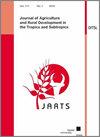刚果民主共和国南基伍省小农养猪生产系统的类型学:挑战与机遇
Q3 Social Sciences
Journal of Agriculture and Rural Development in the Tropics and Subtropics
Pub Date : 2020-06-30
DOI:10.17170/KOBRA-202005281301
引用次数: 2
摘要
在许多热带国家,养猪在农民生计中发挥着重要作用。它通过乘数效应促进最贫困人口的粮食安全以及农村经济的发展。在南基伍省,养猪场几乎完全由小农所有。一些研究试图全面描述该省的养猪系统。这项研究是为了更好地了解生猪生产系统的现状,即他们面临的限制和他们提供的机会。调查是根据对南基伍省989个农场所有者的结构化调查问卷和参与性访谈进行的。收集的数据使用多重对应分析和聚类技术进行分析。结果表明:小户养猪场主要有两种类型,主要在饲养方式和饲养管理上存在差异。其中一类包括在散养系统中养猪的农场,它们消耗饲料和清除饲料(从垃圾和途中捡起的成堆饲料),有时还会与作物残留物和厨房剩菜结合在一起。第二类包括改良养猪场,饲养拴着的猪或在猪舍中饲养,饲料主要基于饲料与厨房剩菜、作物残茬和浓缩饲料的混合。然而,所有这些不同的农场类型都有许多共同的特点,包括拥有当地品种的猪,畜群规模小,没有种猪和缺乏适当的预防措施。结果表明,女性养殖户和经验丰富的养殖户主要拥有具有较好特征(品种类型、管理方式、产仔数等)的猪场。因此,妇女参与养猪业可以为改善这一部门提供更好的前景。此外,获得农业信贷也是促进南基伍省畜牧业投资的另一种选择。所有这些只有通过改善小农生产者进入当地市场的机会才能带来更好的结果。本文章由计算机程序翻译,如有差异,请以英文原文为准。
Typology of smallholder’s pig production systems in South Kivu, Democratic Republic of Congo: Challenges and opportunities
Pig farming plays an important role in farmers’ livelihoods in many tropical countries. It contributes to food security of the poorest as well as the development of rural economy through multiplier effects. In the South Kivu province, pig farms are almost exclusively owned by smallholders. A few studies have attempted to describe thoroughly pig farming systems in this province. This study was undertaken to characterise pig production systems, in order to better understand their current situation, namely constraints they face and opportunities they offer. Investigation was conducted based on a structured survey questionnaire and participatory interviews with the owners of 989 farms in South-Kivu. Collected data was analysed using Multiple Correspondence Analysis and clustering techniques. Results showed that there are two types of smallholder pig farms differing mainly in the type of husbandry and feeding management. One category includes farms that raise pigs in free-range system consuming forages and scavenge feed (heaps picked-up from garbage and trash on their ways), which are sometimes, combined with crop residues and kitchen leftovers. The second category includes improved pig farms raising tethered pigs or in lairage where feed is mostly based on forages combined with kitchen leftovers, crop residues and concentrate feed. Nevertheless, all these different farm types share many common characteristics, including having pigs of local breeds, small herd sizes, absence of breeding boars and absence of adequate prophylactic measures. It emerged that female farmers together with experienced farmers mainly own pig farms with better characteristics (breed type, management practices, litter size, etc.). Hence, the involvement of women in pig farming can offer better prospects for the improvement of this sector. In addition, access to agricultural credit can also be an alternative to foster investment in livestock in South Kivu. All this can only lead to better results though improved local market access to smallholder producers.
求助全文
通过发布文献求助,成功后即可免费获取论文全文。
去求助
来源期刊
CiteScore
2.30
自引率
0.00%
发文量
0
审稿时长
>36 weeks
期刊介绍:
The Journal of Agriculture and Rural Development in the Tropics and Subtropics publishes papers dealing with original research and review papers in the fields of plant production, animal nutrition and animal husbandry, soil science, rural economy and farm management, forestry and forest economy, veterinary hygiene and protection against epidemics.

 求助内容:
求助内容: 应助结果提醒方式:
应助结果提醒方式:


